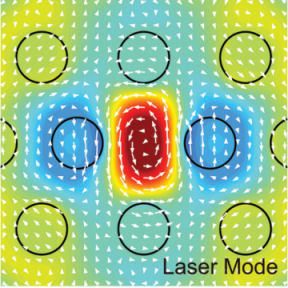- More than 2 years ago
The smallest, most efficient laser yet, a nanoscale device that consumes just 1 microwatt of power, could one day be a component of faster computers.

Toshihiko Baba of Yokohama National University in Japan and his colleagues constructed the tiny laser out of a photonic crystal—a material with internal microstructure that controls the behavior of selected wavelengths of light. In nature, photonic crystals are responsible for the iridescent surfaces of some butterfly wings.
The team shone light from an ordinary laser onto a several-micron-wide slab of semiconductor material pierced with tiny, round holes in a hexagonal pattern. Scattering of light by the holes led to interference among the waves that made the normally translucent slab reflective.
However, the scientists introduced an irregularity by spacing just two holes farther apart than the regular pattern would dictate. This small change modified how light scattered off the slab and caused light of a single wavelength to bounce back and forth between the two displaced holes, which were just a half-micron apart. By effectively trapping light in a tiny space, the photonic material acted as a laser. The results appear in the June 11 Optics Express.
Baba says that high-precision fabrication techniques enabled him and his colleagues to produce a nanolaser one-fifth the size of any that existed before. The smaller laser also operates at lower power and with higher efficiency.
Using tiny laser beams to transmit information between electronic chips could speed up computers with multiple processors, says Tomoyuki Yoshie of Duke University in Durham, N.C.







